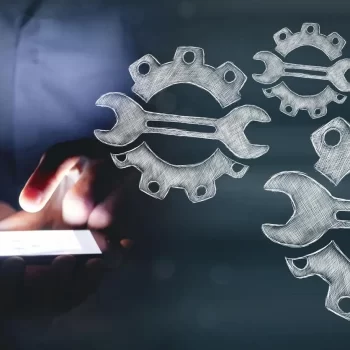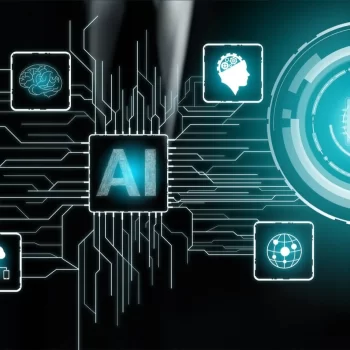The average helpdesk is no longer just a place to report technical issues. It’s becoming the front line in enhancing customer experiences holistically. Helpdesks now play a significant role in shaping a customer’s perception of a brand. The modern AI-Helpdesk agent resolves issues and builds relationships, ensuring customers feel valued and heard.
A recent market report showed that “Around 32% of major businesses around the world have adopted AI customer service technology.”
The fact is that helpdesks are the new brand ambassadors in an age where building customer relationships is as important as resolving issues. Look at it this way: One seamless experience can convert a frustrated user into a loyal customer.
Related blog: When generative AI-Helpdesks take control, will humans make the cut?
Why IT management is a big deal for AI-Helpdesk?
The integration of IT management with AI-Helpdesk operations cannot be understated. A strong IT framework allows quicker resolution times, streamlined processes, and a more organized approach to customer issues. As an agent, understanding the backend processes can empower you to provide better, more informed solutions to the users.
Furthermore, the intertwining of IT management with the AI-Helpdesk ensures that the data and metrics are utilized efficiently. This data can drive insights, predict potential challenges, and ensure the support structure continually evolves to meet customer demands.
In summary, here’s why IT management and AI-Helpdesk operations are forever entwined.
- A sturdy IT framework translates to quicker issue resolutions
- Data-driven insights predict potential problems
- Evolving support structures meet dynamic customer demands
- Smart IT allocation ensures the proper use of resources
How to monitor for potential issues
Anticipating problems before they escalate is an essential skill for modern helpdesks. By using monitoring tools and analyzing data patterns, you can spot potential red flags and address them proactively. This reduces the number of complaints and boosts the customer’s confidence in your services.
This proactive approach means you’re not just waiting for issues to arise but actively working towards creating a smoother user experience. Over time, this can increase customer loyalty and a more positive brand image.
Advantages of proactive issue monitoring:
- Monitoring tools help spot patterns that might indicate bigger issues
- Proactive addressing of potential problems can reduce complaints
- A hands-on approach builds trust with customers
- Active monitoring can improve the overall user experience
- Predictive analysis helps in preempting potential challenges
How to personalize customer interactions
As an agent, personalizing interactions means understanding the customer’s history, their preferences, and even their frustrations. It’s about making them feel like an individual, not just another ticket number. When customers feel like they’re getting the right amount of attention, their trust in the brand grows. It can increase loyalty, boost engagement, and even push word-of-mouth referrals.

After all, personalization in customer service requires a thorough understanding of the customer’s history and preferences. Rather than treating them as mere ticket numbers, customers should feel valued and recognized as individuals.
Hence, offering tailored responses and solutions based on their unique needs will drive up customer satisfaction levels. According to a survey by Microsoft, “30% of customers say talking to a knowledgeable and friendly agent about their issues is crucial to their customer service experience.”
Furthermore, such personalized interactions create avenues for contextual upselling and cross-selling opportunities, distinguishing between a one-time user and a dedicated brand advocate.
Eight experience-critical KPIs fueled by personalization
- First Contact Resolution (FCR): Agents can resolve issues during the initial interaction.
- Customer Satisfaction (CSAT) Score: Customers feel valued, leading to higher satisfaction ratings.
- Net Promoter Score (NPS): Happy, valued customers are likelier to recommend a service to others.
- Average Resolution Time: Agents can pinpoint issues more rapidly, reducing the time to resolve them.
- Ticket Volume: Recurring support issues can be preemptively addressed, reducing the total number of tickets submitted.
- Customer Retention Rate: Satisfied customers whose needs are understood are more likely to stick around.
- Agent Productivity: When support is personalized, agents can often find solutions faster, handling more tickets in the same timeframe.
Impact of contextual upselling and cross-selling
When done right, upselling and cross-selling can add value to the customer’s journey. But the keyword here is “contextual“. As an AI-helpdesk agent, it’s essential to understand the customer’s needs and only suggest products or services that genuinely enhance their experience. This isn’t about pushing sales – but providing valuable solutions. That’s why a recent market study revealed that “72% of customers say they expect companies to know their purchase history regardless of how they chose to connect with the company in the past.”
The technical backbone supporting this approach is a robust helpdesk system integrated with CRM and analytics tools. It allows helpdesk agents to access real-time insights into a customer’s previous interactions, purchases, feedback, and even unresolved issues. This data-rich context empowers the agent to make spot-on recommendations.
For instance, if the system detects that a customer has often faced storage issues with a basic plan, an agent can suggest upgrading to a premium plan with more storage capabilities. It’s a win-win situation: the customer gets a solution customized to a recurring problem, and the business achieves a potential sale.
Related article: AI in Customer Service: Revolutionizing the Helpdesk with 10 Cutting-Edge Examples
Wrapping
The changing dynamics mean that while technical expertise remains a priority, a wider skill set that encompasses communication, empathy, and problem-solving is now crucial. As a helpdesk agent, organizations are positioned to create positive, lasting impressions on customers.
Now more than ever, a helpdesk agent is seen as the face or voice of an organization to a vast majority of its customers. It’s through their interactions with the agent that customers form perceptions about brand values, reliability, and commitment to customer satisfaction.
























